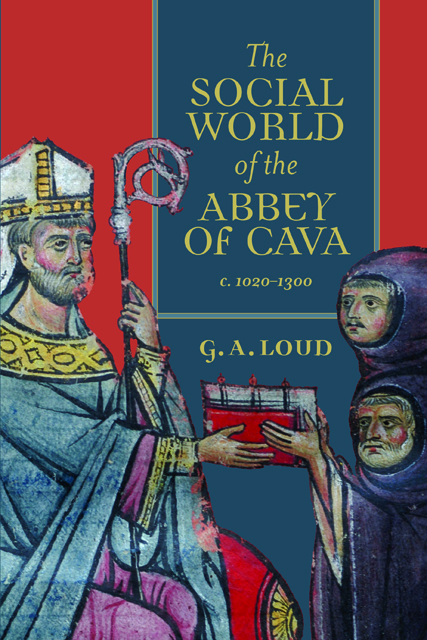Book contents
- Frontmatter
- Dedication
- Contents
- List of Maps and Charts
- Acknowledgements
- List of Abbreviations
- Note on the Organisation and Publication of the Cava Archive
- Dates
- Currency, Weights and Measures
- The Abbots of Cava, c. 1020-1300
- Maps
- I The Family of Vivus Vicecomes
- Introduction
- Part I The Abbey of Cava
- Part II Society and Economy
- Conclusions
- Appendix: Purchase and Expenditure by the Abbey of Cava, at Selected Periods between 1175 and 1230
- Bibliography
- Index
- Other volumes in Studies in the History of Medieval Religion
- Frontmatter
- Dedication
- Contents
- List of Maps and Charts
- Acknowledgements
- List of Abbreviations
- Note on the Organisation and Publication of the Cava Archive
- Dates
- Currency, Weights and Measures
- The Abbots of Cava, c. 1020-1300
- Maps
- I The Family of Vivus Vicecomes
- Introduction
- Part I The Abbey of Cava
- Part II Society and Economy
- Conclusions
- Appendix: Purchase and Expenditure by the Abbey of Cava, at Selected Periods between 1175 and 1230
- Bibliography
- Index
- Other volumes in Studies in the History of Medieval Religion
Summary
The abbey of Holy Trinity, Cava, was founded about the year 1020, when a man called Alferius, a former courtier of the local prince, went to live as a hermit in the hills to the north-west of Salerno, in a cave on the lower slopes of Monte Fenestra. He was soon joined by others, and by 1025, when he received a privilege from Prince Guaimar III (ruled 999–1027), in which he was described as ‘abbot’, an organised monastic community had clearly been established on the site. Nevertheless, for more than a generation, until some years after the death of Alferius in 1050, the monastery remained small and obscure. It was, probably, during these early days more a group of hermits rather than a conventional cenobitic monastery. Only in the 1060s did Cava develop beyond its humble origins, when daughter houses were founded in Salerno itself and at Vietri (between Salerno and Cava), the Rule of St Benedict was adopted, and, towards the end of the decade, it started to acquire property in Cilento, in the south of the principality. But thereafter the expansion of Cava and its congregation was extraordinary, both in its rapidity and extent. Under the third abbot, Peter, who ruled the community for no less than forty-four years (1079–1123), Cava became one of the leading monasteries of southern Italy. It profited spectacularly from the patronage of the new Norman aristocracy, who had recently conquered the region. (The city of Salerno itself fell to the Norman ruler Robert Guiscard in December 1076.) This enabled the monastery to acquire subordinate cells and dependent churches in Apulia, as well as in the principality of Salerno, and to consolidate and expand its existing holdings in its home region. By the mid-twelfth century, Cava was not only a major patrimonial landowner in the principality of Salerno but at the head of a vast congregation of dependencies, stretching over much of southern Italy. A papal bull confirming its property in 1169 listed twenty-one monasteries and no less than ninety-eight other churches that were subject to it. The pace of expansion was by then slowing, and in the thirteenth century Cava was rather defending its existing possessions than acquiring new ones. Nevertheless, the papal taxation lists of the early fourteenth century show it to have been the second wealthiest abbey in southern Italy, after only Montecassino.
- Type
- Chapter
- Information
- The Social World of the Abbey of Cava, c. 1020-1300 , pp. 1 - 10Publisher: Boydell & BrewerPrint publication year: 2021



